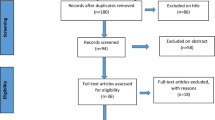Abstract
Background
Chronic neuropathy after hernia repair is a neglected problem as very few patients are referred for surgical treatment. The aim of the present study was to assess the outcome of standardized surgical revision for neuropathic pain after hernia repair.
Methods
In a prospective cohort study we evaluated all patients admitted to our tertiary referral center for surgical treatment of persistent neuropathic pain after primary herniorrhaphy between 2001 and 2006. Diagnosis of neuropathic pain was based on clinical findings and a positive Tinel’s sign. Postoperative pain was evaluated by a visual analogue scale (VAS) and a pain questionnaire up to 12 months after revision surgery.
Results
Forty-three consecutive patients (39 male, median age 35 years) underwent surgical revision, mesh removal, and radical neurectomy. The median operative time was 58 min (range: 45–95 min). Histological examination revealed nerve entrapment, complete transection, or traumatic neuroma in all patients. The ilioinguinal nerve was affected in 35 patients (81%); the iliohypogastric nerve, in 10 patients (23%). Overall pain (median VAS) decreased permanently after surgery within a follow-up period of 12 months (preoperative 74 [range: 53–87] months versus 0 [range: 0–34] months; p < 0.0001).
Conclusions
The results of this cohort study suggest that surgical mesh removal with ilioinguinal and iliohypogastric neurectomy is a successful treatment in patients with neuropathic pain after hernia repair.

Similar content being viewed by others
References
Aasvang E, Kehlet H (2005) Chronic postoperative pain: the case of inguinal herniorrhaphy. Br J Anaesth 95:69–76
Hindmarsh AC, Cheong E, Lewis MP et al (2003) Attendance at a pain clinic with severe chronic pain after open and laparoscopic inguinal hernia repairs. Br J Surg 90:1152–1154
O’Dwyer PJ, Alani A, McConnachie A (2005) Groin hernia repair: postherniorrhaphy pain. World J Surg 29:1062–1065
Poobalan AS, Bruce J, Smith WC et al (2003) A review of chronic pain after inguinal herniorrhaphy. Clin J Pain 19:48–54
O’Dwyer PJ, Kingsnorth AN, Molloy RG et al (2005) Randomized clinical trial assessing impact of a lightweight or heavyweight mesh on chronic pain after inguinal hernia repair. Br J Surg 92:166–170
Bay-Nielsen M, Nilsson E, Nordin P et al (2004) Chronic pain after open mesh and sutured repair of indirect inguinal hernia in young males. Br J Surg 91:1372–1376
Nienhuijs S, Staal E, Keemers-Gels M et al (2007) Pain after open preperitoneal repair versus Lichtenstein repair: a randomized trial. World J Surg 31:17517
Nienhuijs SW, Boelens OB, Strobbe LJ (2005) Pain after anterior mesh hernia repair. J Am Coll Surg 200:885–889
Aasvang E, Kehlet H (2005) Surgical management of chronic pain after inguinal hernia repair. Br J Surg 92:795–801
Amid PK (2002) A 1-stage surgical treatment for postherniorrhaphy neuropathic pain: triple neurectomy and proximal end implantation without mobilization of the cord. Arch Surg 137:100–104
Heise CP, Starling JR (1998) Mesh inguinodynia: a new clinical syndrome after inguinal herniorrhaphy? J Am Coll Surg 187:514–518
Collins SL, Moore RA, McQuay HJ (1997) The visual analogue pain intensity scale: what is moderate pain in millimetres? Pain 72:95–97
McCarthy M Jr, Chang CH, Pickard AS et al (2005) Visual analog scales for assessing surgical pain. J Am Coll Surg 201:245–252
Melzack R (1987) The short-form McGill Pain Questionnaire. Pain 30:191–197
Amid PK (2005) Groin hernia repair: open techniques. World J Surg 29:1046–1051
Mui WL, Ng CS, Fung TM et al (2006) Prophylactic ilioinguinal neurectomy in open inguinal hernia repair: a double-blind randomized controlled trial. Ann Surg 244:27–33
Alfieri S, Rotondi F, Di Giorgio A et al (2006) Influence of preservation versus division of ilioinguinal, iliohypogastric, and genital nerves during open mesh herniorrhaphy: prospective multicentric study of chronic pain. Ann Surg 243:553–558
Wijsmuller AR, van Veen RN, Bosch JL et al (2007) Nerve management during open hernia repair. Br J Surg 94:17–22
Acknowledgments
The authors thank Rachel Rosenthal for editorial advice and Marc Grand D’Hautville for providing Fig. 1.
Author information
Authors and Affiliations
Corresponding author
Rights and permissions
About this article
Cite this article
Vuilleumier, H., Hübner, M. & Demartines, N. Neuropathy After Herniorrhaphy: Indication for Surgical Treatment and Outcome. World J Surg 33, 841–845 (2009). https://doi.org/10.1007/s00268-008-9869-1
Published:
Issue Date:
DOI: https://doi.org/10.1007/s00268-008-9869-1




